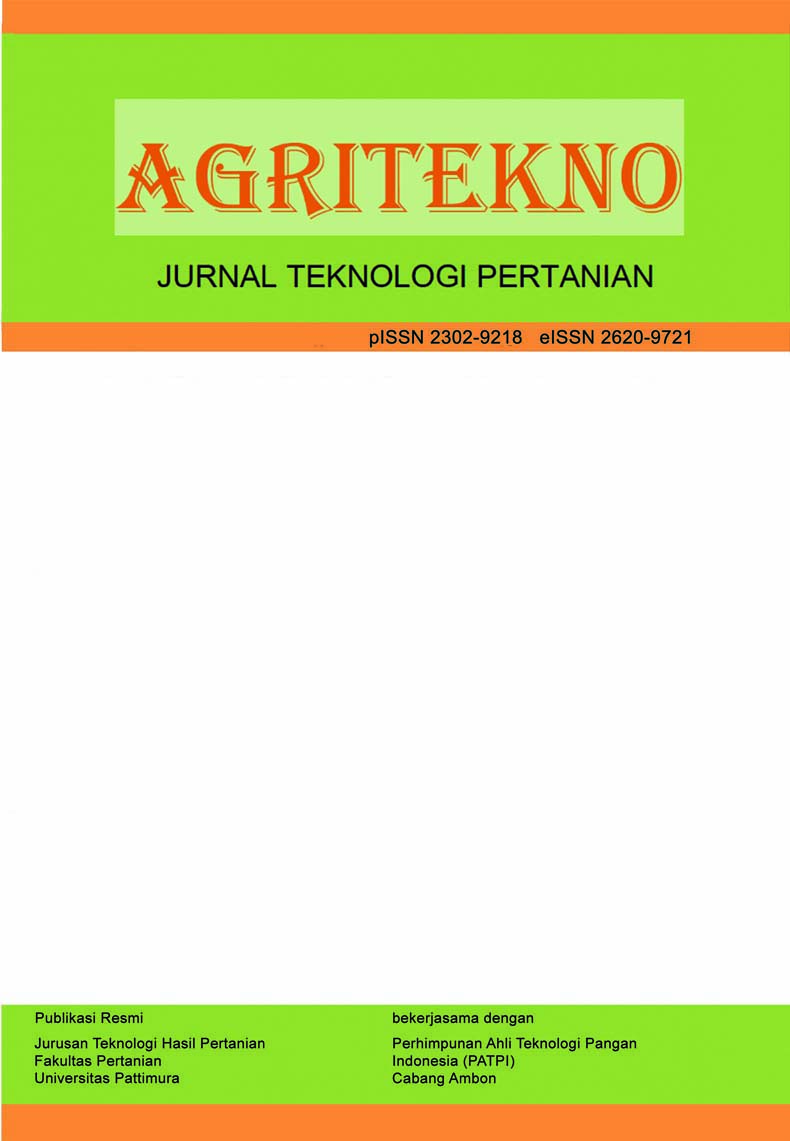Karakteristik Kimia dan Sensori Brownies Ubi Jalar Putih dengan Penambahan Tepung Kacang Hijau
Chemical and Sensory Characteristics of White Sweet Potato Brownies with the Addition of Mung Bean Flour
Abstract
Brownies are a kind of cake that is dark brown in color, has a smooth texture and special taste, and does not require baking powder. White sweet potatoes and mung beans can be used as raw material for brownies, where white sweet potatoes have a fairly high carbohydrate content while mung beans have a high protein content. The purpose of this study was to obtain the effect of white sweet potato and mung bean flour on the chemical and sensory characteristics of brownies and to obtain the best ratio. The treatment in the study consisted of five treatments and three replications and used a CDR (Completely Randomized Design). The ratios of white sweet potato and mung bean flour, namely 100:0, 90:10, 80:20, 70:30 and 60:40. The results of the research on the selected treatment were 80% white sweet potato flour : 20% mung bean flour, which had moisture content of 30.44%, ash content of 0.96%, fat content of 20.31%, protein content of 12.42%, carbohydrate content of 35.88%, and fiber content of 6.62%. The descriptive test showed that the brownies had a brown color, mung beans and sweet potato flavor, mung beans and sweet potato taste, and soft texture.
Downloads
References
Andarwulan, N., Feri, K., & Dian, H. (2011). Analisis Pangan. Jakarta: Dian Rakyat.
Aprilia, N. P. R. D., Ni, M. Y., & Desak, P.K P. (2019). Perbandingan modified cassava flour (MOCAF) dengan tepung kacang hijau (Vigna radiate L.) terhadap karakteristik sponge cake. Jurnal Ilmu dan Teknologi Pangan, 8(2), 171–180.
Azizah, Y. N., Dian, R. A., & Dimas, R. A. M. (2014). Formulasi dan kajian karakteristik nasi jagung (Zea mays L.) instan yang disubstitusi tepung kacang hijau (Phaseolus radiatus). Jurnal Teknosains Pangan, 3(1), 84–95.
Badan Pusat Statistik. (2020). Impor Biji Gandum Menurut Negara Asal Utama 2010‒2019. Jakarta: Badan Pusat Statistik.
Badan Standardisasi Nasional. (1995). SNI 01‒3840‒1995. Roti Manis. Jakarta: Standar Nasional Indonesia.
Fathullah. (2013). Perbedaan Brownies Tepung Ganyong dengan Brownies Tepung Terigu Ditinjau dari Kualitas Inderawi dan Kandungan Gizi. Skripsi. Universitas Negeri Semarang. http://lib.unnes.ac.id/18903/1/5401407056.
Irmae, Noor, T., & Rina, O. (2018). Variasi campuran tepung terigu dan tepung kacang hijau pada pembuatan nastar kacang hijau (Phaseolus radiatus) memperbaiki sifat fisik dan organoleptik. Jurnal Nurisia, 20(2), 77‒82.
Jumanah, J, Maryanto, M., & Rina, O. (2017). Karakterisasi sifat fisik, kimia, dan sensori bihun berbahan tepung komposit ganyong (Canna edulis) dan kacang hijau (Vigna radiata). Jurnal Agroteknologi, 11(2), 128‒138.
Khotijah, S. F. (2015). Eksperimen Pembuatan Brownies Tepung Terigu Substitusi Tepung Jerami Nangka. Skripsi. Universitas Negeri Semarang. Semarang.
Kusnandar, F. (2020). Kimia Pangan: Komponen Makro. Jakarta: PT Bumi Aksara.
Mahmud, M. K., Hermana, Nazzarina, Marudut, Nisa, A., Muhayatun, Abas, B. J., Dewi, P., Fitrah, E., Rugayah, Haryono, Sri, P., Umi, F., Ahmad, S., Nuri, A., Atmarita, Nunung, N., Nurul, I., Galopong, S., Eko, P., & Lina, M. (2018). Tabel komposisi Pangan Indonesia 2017. Jakarta: Kementerian Kesehatan.
Massytah, H. A., Gusti, A. E., & Ni, W. W. (2019). Perbandingan mocaf dengan tepung kacang merah dalam pembuatan brownies kukus gluten free casein free (GFCF). Jurnal Ilmu dan Teknologi Pangan, 8(1), 1–7.
Noer, S. W. M., Mohammad, W., & Kadirman. (2017). Pemanfaatan tepung ubi jalar (Ipomea batatas L.) berbagai varietas sebagai bahan baku pembuatan kue bolu kukus. Jurnal Pendidikan Teknologi Pertanian, 3(1), 60‒71.
Prayitno, S. A., Restu, T., & Fadjar, K. H. (2018). Sifat kimia dan organoleptik brownies kukus dari proporsi tepung mocaf dan terigu. Jurnal Teknologi dan Industri Pertanian Indonesia, 10(1), 7‒21.
Rakhmah, Y. (2012). Studi Pembuatan Bolu Gulung dari Tepung Ubi Jalar (Ipomoea batatas L.). Skripsi. Universitas Hasanuddin. https://core.ac.uk/download/pdf/25488377.
Ratnasari, D, & Yunianta. (2015). Pengaruh tepung kacang hijau, tepung labu kuning, margarin terhadap fisikokimia dan organoleptik biskuit. Jurnal Pangan dan Agroindustri, 3(4), 1652‒1661.
Ruhutami, D., S. Setyowati, & Farissa, F. (2018). Pengaruh variasi pencampuran tepung kacang hijau (Phaseolus radiatus) pada pembuatan brownies singkong kukus terhadap sifat fisik, sifat organoleptik, dan kadar protein. Jurnal Teknologi Kesehatan, 14(2), 46–55.
Santosa, I., Andinni, P. W., & Endah, S. (2016). Kajian sifat kimia dan uji sensori tepung ubi jalar putih hasil pengeringan cara sangrai. Jurnal Teknik Kimia, 3(2), 55–60.
Sudarmadji, S., Bambang, H., & Suhardi. (1997). Prosedur Analisa untuk Bahan Makanan dan Pertanian (Keempat). Yogyakarta: Liberty.
Sugiyono. (2003). Teknologi Pengolahan Tepung Serealia dan Umbi-Umbian. Pusat Studi Pangan dan Gizi. Bogor: Institut Pertanian Bogor.
Widiantara, T., Dede, Z. A., & Eska, Y. (2018). Kajian perbandingan tepung kacang koro pedang (Canavalia ensiformis) dengan tepung tapioka dan konsentrasi kuning telur terhadap karakteristik cookies koro. Pasundan Food Technology, 5(2), 146‒153.
Winarno, F. G. (2008). Kimia Pangan dan Gizi. Jakarta: Gramedia Pustaka Utama.
Yanti, S., Nur, W., & Heru, P. H. (2019). Pengaruh penambahan tepung kacang hijau terhadap karakteristik bolu kukus berbahan dasar tepung ubi kayu (Manihot esculenta). Jurnal TAMBORA, 3(3), 1–10.
Copyright (c) 2024 The Author(s)

This work is licensed under a Creative Commons Attribution-ShareAlike 4.0 International License.
Authors who publish with this journal agree to the following terms:
- Authors retain copyright and grant the journal the right of first publication with the work simultaneously licensed under a Creative Commons Attribution License that allows others to share the work with an acknowledgement of the work's authorship and initial publication in this journal.
- Authors are able to enter into separate, additional contractual arrangements for the non-exclusive distribution of the journal's published version of the work (e.g., post it to an institutional repository or publish it in a book), with an acknowledgement of its initial publication in this journal.
- Authors are permitted and encouraged to post their work online (e.g., in institutional repositories or on their website) prior to and during the submission process, as it can lead to productive exchanges, as well as earlier and greater citation of published work (See The Effect of Open Access).









